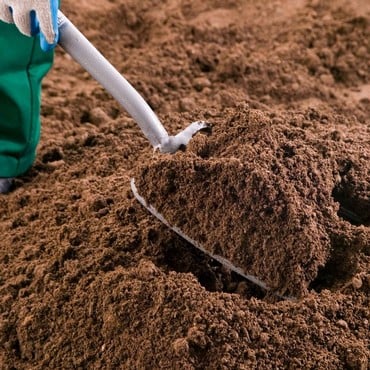Know Your Soil
Knowing your soil type will help you choose the right plants and vegetables for your garden and will help you maintain them in good condition without costly mistakes.
Quick summary of soils:
- Clay Soils - are heavy, high in nutrients, wet and cold in winter and baked dry in summer.
- Sandy Soils - are light, dry, warm, low in nutrients and often acidic.
- Silt Soils - are fertile, light but moisture-retentive and easily compacted.
- Loams - are mixtures of clay, sand and silt that avoid the extremes of each type of soil.
- Peat soils - are very high in organic matter and moisture.
- Chalky soils - are very alkaline and may be light or heavy.
Identifying your soil type:
The best way to identify your soil type is by touching it and rolling it in your hands.
Clay soil - This soil type has a smearing quality and is sticky when wet. It is easily rolled into a long thin sausage and can be smoothed to a shiny finish by rubbing with a finger. If it is not heavy clay it won’t get quite as shiny and be as easy to make into a sausage shape.
Sandy soil - This soil type has a gritty texture, you can feel the sand grains within it and it falls through your fingers. It cannot be rolled to make a sausage shape. If it is not a coarse sand and perhaps a sandy loam it may stick together better.
Pure Silt soil - This soil type is very rare especially in gardens. It has a slightly soapy, slippery texture and does not clump easily.
Working with your soil:
Now you know what type of soil you have, you can start to work with it and improve it before you get planting.
Clay soils - are rich in nutrients and are very fertile if their cloddiness can be broken up by the addition of organic matter. This breaks down the clay into separate crumbs, making the water and nutrients held within the clay more easily available to plant roots. Breaking up the clay into crumbs also makes the soil warmer, more easily workable and less prone to compaction.
Sandy Soils - are light soils usually low in nutrients, and lose water very quickly being particularly free-draining. You can boost the water and nutrient holding capacity of your soil by adding plenty of organic matter to bind the loose sand into more fertile crumbs. Fertilisers may also be necessary to give plants grown in sandy soils an extra boost.
Silt soils - are made up of fine particles that can be easily compacted by treading and use of garden machinery. They are prone to washing away and wind erosion if left exposed to the elements without plant cover. However, they contain more nutrients than sandy soils and hold more water, so tend to be quite fertile. You can bind the silt particles into more stable crumbs by the addition of organic matter.
Loam type soils - are the gardener’s best friend, being a ‘perfect’ balance of all soil particle types. But even though they are very good soils, it is important to regularly add organic matter, especially if you are digging or cultivating these soils every year.
Chalky soils - are alkaline, so will not support ericaceous plants that need acid soil conditions. Very chalky soils may contain lumps of visible chalky white stone. Such soils cannot be acidified, and it is better to choose plants that will thrive in alkaline conditions. Many chalky soils are shallow, free-draining and low in fertility, but variations exist, and where there is clay present, nutrient levels may be higher and the water holding capacity greater.
Another important aspect of soil type, is the pH (acidity or alkaline). This will also affect the type of plants you can grow and how you manage your soil - see more information on soils and pH in Soil Types & Improving in the Growing Advice section.

























